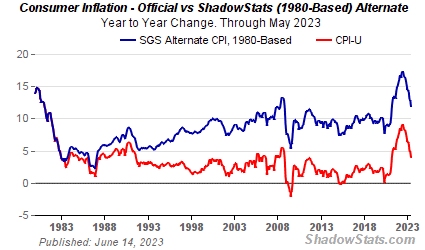Certainly when you look today, you will see a strong case for deflation: a weak consumer, in both the US and Europe, rising unemployment, excess capacity and debt problems everywhere (an example of one of many arguing the deflation case can be found here).
Does that mean that inflation is dead? Not quite. Shadowstats’ CPI figures show that their alternate CPI is north of 9%:

What kind of inflation?
The question shouldn’t be one of inflation or deflation, but what kind of inflation given the deflationary landscape. Scott Grannis at Calafia Beach Pundit showed that there is inflation in services but deflation in durable goods:
To that analysis, I would add “inflation in raw materials”. As I wrote before:
A portfolio that relies on commodity and commodity-linked equities would be an effective inflation hedge under such a scenario. However, portfolios that rely on fixed income based solutions, such as inflation-indexed bonds like TIPS or even yield steepener trades, may be less effective as these kinds of inflationary signals may not show up as well in those markets.
Timing the inflation/deflation trade
I think that another reason that many market participants are confused about the inflation vs. deflation debate is the degree of macro-economic volatility that we are observing. While it is true there is a great degree of volatility in the economic outlook, investors can profit from that volatility with a timing system such as the inflation-deflation timer model, which is currently showing a neutral reading right now.



3 comments:
Understanding this duality is the most important problem our governments face. Even the prominent macro academics fail to frame it in the way you have.
Please take a look here and track back the links. It's even worthwhile to look through the comments.
http://delong.typepad.com/sdj/2010/05/delong-smackdown-watch-mark-thoma-on-why-the-macroeconomic-playbook-wasnt-consulted.html#comments
Interesting that the Inflation-Deflation Model is back to Neutral (Stocks over Commodities). Perhaps slower growth in China & Europe is causing the move away from "Inflation." Lower Global GDP growth, stable US $, lower gas prices, and lower US mortgage rates all support domestically focused US equities. Just wondering if the Inflation-Timer can be further enhanced as a Sector Rotation Model (e.g., XLE and XLB could under-perform XLF, XLV when reading is "Neutral").
WimpyInvestor -
The reasoning behind a 100% stock allocation when the Inflation Deflation Timer model shows a neutral reading is that the environment is relatively "benign" as the readings do not show runaway inflation nor deflation. However, given the macro risks I would be more defensive in an actual portfolio.
The inflation-neutral-deflation readings of the model could also be mapped to a risk (inflation) tp safety (deflation) scale. While I haven't done any work on it, it could conceivable be turned into a sector or industry allocation model.
Post a Comment